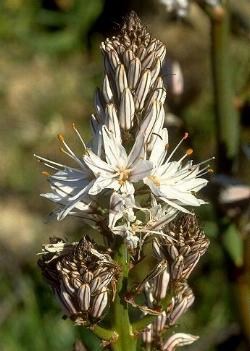April
2002
Did you know that
Ancient Greeks regarded asphodels as the form of food preferred by the
dead,
as they believed that there
was a large
meadow overgrown with asphodel in Hades?
 |
|
Asphodelus
ramosus- Asphodel
|
- Asphodelus -
Asphodel
These perennials of the Liliaceae family are natives of central and
southern Europe. About 12 species of this plant are distributed over a
large area extending from the Mediterranean region to India. The common Asphodelus populates open
territories in the Mediterranean region, and deeply invades the desert
regions. The roots are finger or carrot like, colored brown and are
filled with juice. The plants form
clumps of flattened, linear, medium green leaves, like onion leaves, that grow up to 60 cm
long. In late spring and early summer, they produce thick-stemmed
racemes of small, star-shaped, white flowers. The
fruit is an egg like capsule. These plants grow up to
1 meter high and spread 40cm. It is only cultivated in botanical and
ornamental gardens, though it easily grows from seeds or division of
roots. The roots must be gathered at the end of the
first year.
The ancients planted the flowers
near tombs, regarding them as the form of food preferred by the dead,
and many poems refer to this custom. The name is derived from a Greek
word meaning sceptre. Artemidorus in his Oneirocritica
(3.50): "An asphodel... portends death only for
the sick, as I have frequently observed. I am unable to state with
certainty
why this is so, but it is probably because the plains of Hades are
believed to
be full of asphodels."
Homer (Ody. XI.539; XI. 573; XXIV.13) mentions a field of asphodel
twice during Odysseus' visit to the underworld and again when the
souls of the suitors are being led by Hermes into the underworld.
Hesiod (W&D 41), however, describes asphodel as a poor man's fare
without
alluding to the superstition which connected the plant with the
underworld.
Lucian (De Luctu 5,19) confirms that the Greeks believed that there
was a large
meadow overgrown with asphodel in Hades.
Hesychius (s.v. asphodelos) states that the asphodel is a fragrant
plant whose root, according to Aristarchus, is edible.
The roots, dried and boiled in water, yield a
mucilaginous matter that in some countries is mixed with grain or
potato to make Asphodel bread. In Spain and other countries they are
used as cattle fodder, especially for sheep. In Barbary the wild boars
eat them greedily. In Persia, glue is made with the bulbs, which
are first dried and then pulverized. When mixed with cold water, the
powder swells and forms a strong glue. Hippocrates, Dioscorides, and Pliny said the
roots were cooked in ashes and eaten. The Greeks and Romans used them
in several diseases, but they are not employed in modern medicine. The folk medicine use of Branched Asphode is still
practiced by the Arabs of Israel in
treating hard warts that grow in between knuckles of hand and feet.
Indeed, there isn't an efficient and used remedy for removing warts as
roots of Asphodelus. Other medicinal uses are for treating jaundice,
eczema, swollen feet, cracked skin and to relief gas from the stomach.
Source:
http://www.botany.com/asphodelus.html
http://www.geocities.com/HotSprings/Bath/6482/
english/plants/irit.htm
http://www.botanical.com/botanical/mgmh/a/aspho080.html
http://omega.cohums.ohio-state.edu:8080/hyper-lists/
classics-l/99-07-01/0609.html
|
